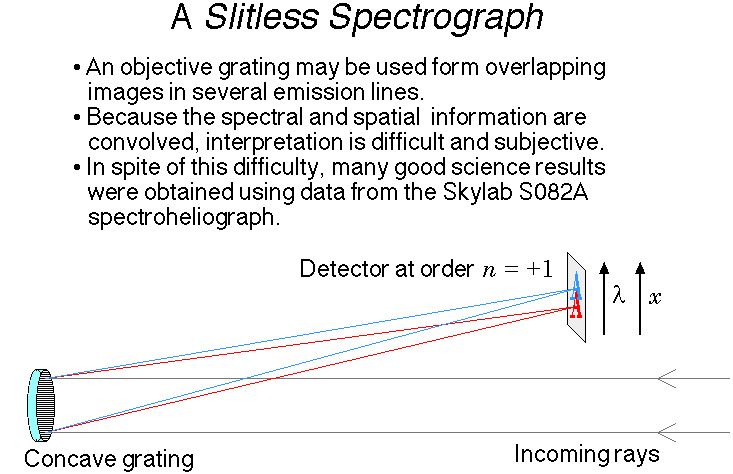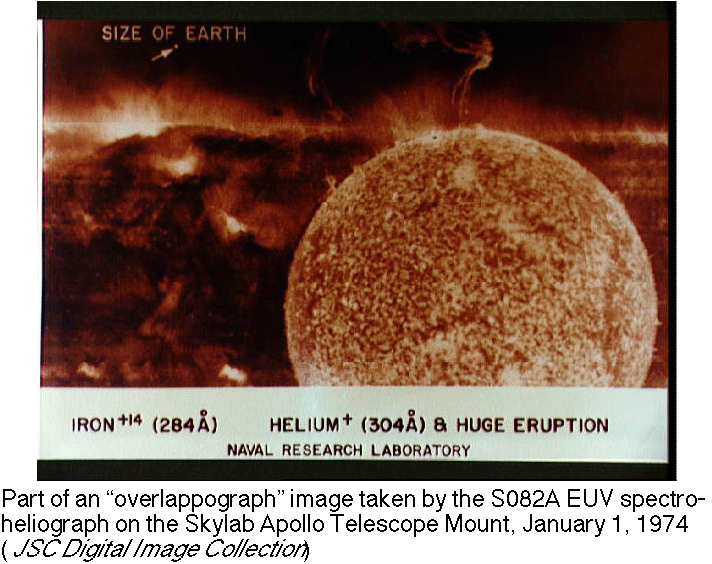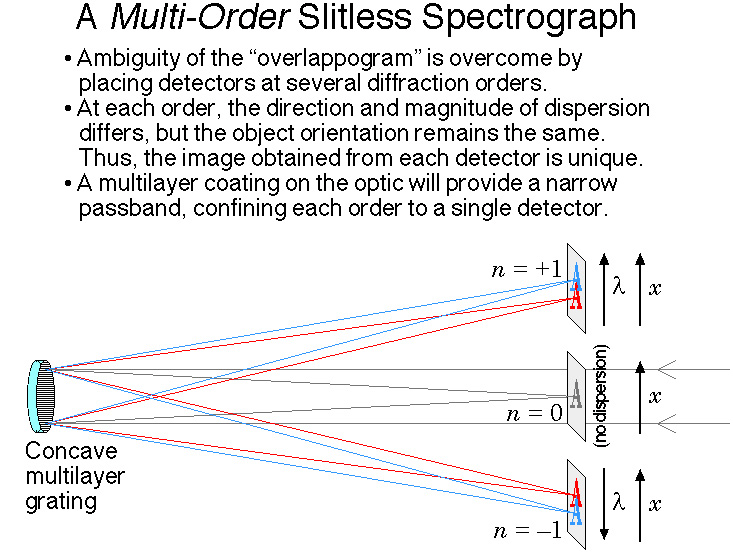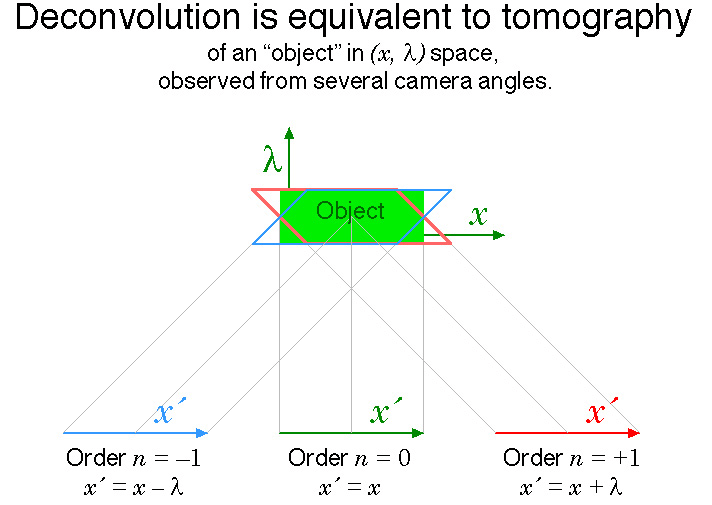![]()
SYNOPSIS OF SUMMER WORK: PREPPING
FOR MOSES
For solar physicists, a complete picture of the sun can never be made by
merely taking images. In taking a basic optical image, an unbelievable
wealth of information slams into the detector, just waiting to be picked
apart by a curious physicist. Spectroscopy (the process of breaking
apart and studying the individual wavelengths of the sun's energy) is one
of physicists' greatest tools in studying the sun. But one of the
nagging difficulties of solar spectroscopy lies in obtaining co-temporal
images of a full-disk sun.
To illustrate, a normal slit spectrograph will only take pictures of the
sun in "slices." Say, for example, that an instrument's imaging slit
is oriented along the y-axis. With this arrangement, a single image
will provide a picture of the sun in "y" and "lambda" coordinates.
In other words, we could image how the sun's intensity varies with vertical
position and wavelength. The drawback here is that this image only
corresponds to one spot on the x-axis. In order to get a full-disk
image, the instrument must be swept laterally across the sun's surface,
taking images at different x-locations until information about the entire
disk is obtained. This is a problem. Why? Because this
process of sweeping accross the sun takes time. And in the time it
takes to image the sun from one side to other, some of the features of
the sun that were imaged first will have changed in the time it took to
get to the opposing side of the sun. Thus, the images are not co-temporal.
Ideally, we'd like a way to control the time element, such as making the
sweep time approach zero. This isn't very practical. So instead,
another solution is to eliminate the need for "sweeping" altogether.
This can be done by using a multi-order slitless spectrograph.
Using this technique, physicists can get a picture of how the sun's intensity
varies as a function of x, y, wavelength, and time--or " I(x,y,lambda,t)
".
But this is not to say that interpretation of this data is easy.
With a slit-spectrograph, the only thing that has to be delt with is a
series of parallel emission lines. But with the slitless spectrograph,
a series of whole "suns" is obtained. At the center of the instrument
detector, there will be a zeroeth diffraction order sun image. With
this image, there will be no dispersion, and all wavelengths will combine
in intensity in a straightforward fashion. But away from the center,
you will find other diffraction orders (ie -2, -1, +1, +2, etc.).
With, say, the n = +1 order, there will be one complete sun to show up
on the CCD camera for EACH emission line. As you might guess, this
can lead to some very complicated overlapping. We might call
these images "overlappograms." Any adjacent lines (or nearly adjacent
lines, for that matter) may have their data combining on many of the pixels.
Here is an illustration of the technique used by the Skylab mission:

Figure 1:
A skematic of the instrument used inthe Skylab mission. Such an arrangement
produced images such as that seen below.

Figure 2: +1 order overlappogram from the Skylab mission.
In Figure 2, the bright solar image to the right of center is He II emission.
There are several "suns" to the left of this, each representing different
wavelengths. Some of them are quite difficult to pick out, especially
the Si XI sun, which has its left limb JUST left of the He II disc.
It is quite clear how the interpretation of all this data might be rather
difficult. It's not always going to be obvious which photons belong
to each wavelength!
As the slitless spectrograph has been used on solar missions before, such
as Skylab, it will be used again on the MOSES mission (Multi-Order Solar
EUV Spectrograph). However, there are a couple of key differences
between MOSES and those missions that have come before it. On Skylab's
slitless spectrograph, the passband (range of detected frequencies) was
quite large. As a result, there were dozens of "suns" on the each
overlappograph image. Further, only the +1 order was imaged--see
Figure 1. Actually, the passband is so large such that there is some
+2 order data is mixed up in it. With MOSES, the -1, 0, and +1 orders
will be imaged. Further, the passband will be such that only two
wavelengths reach the detectors. Specifically, the passband will
be about 21 Angstroms (FWHM), centered at 304 Angstroms. The only
two significant emission lines in this regsion will be Si XI and He II
(303.3 and 303.8 Angstroms, respectively). The main line of study
for the MOSES mission will be the He II 304 Angstrom line. Here is
an diagram of the MOSES instrument:

Figure 3: A skematic of the MOSES mission data collection.
The main focus of study for the MOSES mission will be the He II data.
The proposed mechanism for the He II emission line is "collisional excitation."
If this is true, solar physicists will expect to see a Gaussian profile
for all of the He II emission (or at least a Gaussian core). And
they would also expect to see "upflows" in the brightest of surface elements.
Also, the relationship between HeII intensity and doppler shift is not
yet well understood. Hopefully, physicists will gain some insight
into this question. And while HeII intensity and line width
are already understood to be inversely related, it is hoped that this correlation
can be nailed down with greater accuracy.
Ok, so that's the background on the mission. So you must be wondering
where the heck I come in, right? Well, right here. As with
any astronomical mission, scientists can never be exactly sure what the
data to be obtained will look like. If they did, it wouldn't be a
very fun mission. So my assignment this summer has been to model
the sun based on how it is understood today. From these solar models
that I have constructed, I have produced the correpsonding "overlappograms."
From here, it is the job of Lewis Fox (grad student of Dr. Kankelborg)
to "deconvolve" the overlappograms and see if he can reconstruct the original
solar models that I have made. Based on what he can find, we hope
to get an idea of what kinds of features are within the range of detection
on this mission. It will help to give an idea of just what we can
reasonably hope to detect, and what kinds of features and resolution might
be out of reach.
Great, so let's get into some of the more meaty details on how I actually
did this. Obviously, I needed some kind of real data with which to
model the sun. It was decided that I could use TRACE (Transistion
Region and Coronal Explorer) data to meet this purpose. The TRACE
resolution is very similar to that expected from MOSES. ALso, TRACE
mission focused on a very similar region of the sun. The He II line
is in the upper chromosphere/lower transition region, so TRACE data should
be a pretty good model.
So, for the first week or so I was at MSU, I spent my time sifting through
TRACE data, becoming familiar with what was available and how to obtain
it. I also became familiar with running on UNIX and using IDL.
I started manipulating TRACE images by writing simple programs to allow
IDL to read and process the data. This was all useful and instructive,
but in order to truly simulate the sun, I needed to construct entire data
cubes. These cubes would have two spatial dimensions, with the third
dimension being wavelength. So, the cubes would have the dimensions
of x, y, and lambda. The program to construct these data cubes was
my main project of the summer.
Essentially, these data cubes contain horizontal and vertical information
about the disk as well as spectral information. The cubes can be
thought of as (x,y) images layered along the lambda axis. So, taking
an (x, y) slice along lambda axis would essentially give one a picture
of what the sun looks like at that specific wavelength. Here is a
nice way to visualize the cube:
Figure 4:
A visualization of a datacube. Note how the images have a thickness
to them. The thickness you see actually represents different layers
of the data cube along the lambda axis. The black areas between and
outside of the two main images are simply zeroes, corresponding to regions
in which the sun is emitting no light.
So that brings us to how the data cubes were made. Again, during
the MOSES mission, only two strong wavelengths will make up almost all
of the light detected (Si XI and He II). Therefore, two wavelengths
from the TRACE data were chosen to represent each of these. Fe X
(171 Angstroms) was chosen to simulate the Si XI line, because there is
good reason to believe they should behave in a reasonably similar fashion.
The lyman alpha emission line was chosen to simulate the He II emission.
Because the images at 1216 Angstroms are not purely lyman alpha (they have
a continuum component), a linear combination of 1216 and 1600 Angstrom
images were was used. In essence, a small piece of a 1600 Angstrom
image was subtraced from a 1216 image.
Once the images were chosen, they had to be manipulated and processed in
various ways before they were "placed" in the data cube. This processing
involved filtering out hot pixels, correcting for misalignments in the
images, normallizing for exposure time, and other minor adjustments.
The images also needed to be put in a reasonable intensity ratio.
Since, the He II emission is on the order of 10 times brighter than the
Si XI emission, I gave the lyman alpha and Fe X images a 10:1 intensity
ratio. At this point, they were almost ready for insertion into the
data cube. For making each individual data cube, my program constructed
an empty cube that could fit the images inside. I gave the cube 101
layers in the lambda direction. The way I set it up, the cube contained
wavelengths from 303.00 - 305.00 Angstroms, resulting in a ratio along
the lambda axis of (0.02 Angstroms) / (cube layer). At this point,
I could have simply inserted the images into the datacube at the correct
layers. Converting from Angstroms to cube layers, this would place
the Fe X (the 303.3 A substitute) at the 16th layer, or i = 15 when indexing
at 0. To place the lyman alpha image (the He II substitute) at 303.8
A, it would go in the i = 40 layer. However, this would not be a
very realistic sun, because we all know that you simply never find an emission
line exactly where it is supposed to be, and as skinny as can be.
Linewidths and doppler shifts make it much more interesting than that.
For there is always a certain width or blurring of the emission line, and
a certain red/blueshift of a line (both of which can vary with intensity
and/or location). So the final step was to add the bandwidths and
doppler shifts to the images. This was done on a pixel by pixel basis.
So if you can imagine what this does, the lyman alpha image would not necessarily
be centered at the i = 40 layer anymore (depending on what kind of red/blueshift
I gave it). And let's say there was an intensity of 500 at a given
pixel. The effect of adding the linewidth effectively "spread" these
500 counts out along lambda axis. Adding the linewidth and doppler
shifts is kind of like shaking the cube along the lambda axis, moving some
of the counts forward or back, and distributing their intensity in each
direction.
In handling the linewidths, I wrote the program such that He II pixel intensity
and linewidth were inversely related, since this has been confirmed by
prior observations. The brighter the pixel, the skinnier the line.
There was not much literature on this relationship for the Si XI line,
so I simply did the same thing for the Si XI linewidth. However,
I left the linewidth constants as adjustable parameters for both the Si
XI and He II images. The relationship between intensity and doppler
shift for either of these lines has not yet been determined; that is if
there is one. Therefore, I also left the doppler shift constants
as adjustable parameters, allowing for varying degrees of red or blueshift.
If one wishes to do something entirely different with the doppler shift,
I wrote a program which allows the user to select specific regions of interest
and manually insert a desired doppler shift. This way, one could
choose any specific number of features, such as a sunspots, and give them
a specific doppler shift.
Once a datacube has been made, the final step is to construct from it the
corresponding overlappograms. There is a nice way of envisioning
how the overlappograms are constructed.

Figure 5: This is a possible way of envisioning the MOSES data collection. It was this schematic that I modelled my overlappogram program after.
While the program I wrote to do this was quite short, it was the most challenging
task of my summer. The program works in a conceptually similar way
to the diagram in Figure 3. Using FOR loops, the program summed up
the pixel counts in the three different "directions" in order to create
the -1, 0, and +1 images. After these were done, the program adds
some Poisson noise to the overlappograms to make them realistic end products.
These final overlappograms are the simulated MOSES data. It is the
job of Lewis Fox to see if he can use the overlappograms to "get back"
to my original data cubes (the real sun). Depending on what Lewis
may find, we may better understand how successful the MOSES mission will
be at resolving actual solar features. If Lewis can successfully
get back to the data cubes, then we can be optimistic that the MOSES findings
will accurately reflect the "real sun."
To be fair, I have the easy job, and Lewis gets all the headaches.
All I have to do is make the datacubes and overlappograms, while Lewis
has to use the overlappograms I throw at him, and be clever enough to get
back to the data cubes. There is literally an infinite number of
possible data cubes that could produce a given trio of overlappograms.
There is no one solution. Some of the data cube solutions will be
non-sense; they won't gel with reality. Lewis has to narrow the possibilities
down to data cubes that correspond with our understanding of the laws of
physics. This idea is rather similar to that which we use when, in
a mechanics problem, we must solve a quadratic equation for the "time"
variable: Sometimes we will get two answers--one which is negative
and one which is positive. We will always go with the positive answer,
because it just doesn't make any sense to talk about negative times.
I can't say enough how much I've enjoyed my experiences here this summer.
I feel that I gained some very useful experience with UNIX and IDL.
And I believe I have a better grasp on what graduate school is like.
Thanks to all the wonderful physics faculty and staff at MSU for making
my summer one that I'll always look back on with a big smile.
**My special thanks
go to Dr. Kankelborg and Lewis Fox for their advice and instruction this
summer. I had no previous computing experience coming into this program.
It was largely through their assistance that I was able to successfully
write all of the programs I made this summer.
![]()
I have been interested in science from a young age. During my high
school career, I started to become very serious about a career in science.
Both chemistry and physics were very appealing to me. But during
my senior year, I took an astronomy class because I thought it would be
interesting--talk about an understatement! That class became the
foundation of my love for astronomy. Shortly after the class ended,
I started reading all the astronomy books I could get my hands on.
I looked up at the stars each night, delighting in my growing familiarity
with the constellations of each season. The stars began to
comfort me. As a teenager trying to figure out the world, I could
return to them each evening, and their remarkable punctuality and predictability
gave me reassurance.
My passion for astronomy grew, and I began to hunger for more. I
dreamt of owning a large telescope. I ended up using a huge portion
of my savings on a 10 inch Newtonian, equatorially mounted. I must
admit it was far more than I was ready for. I had not realized that
my working knowledge of the night sky did not assure me any success at
using my bulky telescope. I initially had great difficulty finding
objects with it. Those I did find, like Mars, looked nothing like
the magazine pictures. I was worried that I was in over my head.
But then, in one single month, I got to view the moon, Jupiter, and Saturn.
In the process, I fell in love with my telescope. I became much better
at finding objects. I eventually started a journal, and had several
solo observing nights spent cataloguing Messier and NGC ojbects from my
backyard. But my biggest pleasure with my telescope was to show others
the wonders of the night sky. I began having all of my friends (and
their friends) over to my house for nights of observing, discussion, and
fun.
My passion for astronomy carried directly over into my undergraduate career.
Before I even got started with classes my freshman year, I got a job giving
shows in the planetarium. I have enjoyed that job immensely, and
have been doing it for four years. I give about 4 shows a week (almost
all of which are live, so these poor souls have to put up with one full
hour of Mark Reiser for each visit). One of these shows is a weekly
public show on Mondays at 8:00, in which I give an in-depth overview of
what is going on in the current night sky, showing the visitors constellations,
bright stars, planets, deep-sky objects, etc. I also get to do a
few shows a week for private groups, such as school groups or boy scouts.
For the past 3 years, I have also been leading observatory sessions for
the public, in which I show interested visitors the planets and various
deep-sky objects, while providing background and answering questions.
It has been very enjoyable, especially when I get the opportunity to swap
stories or experiences with other eager observers.
Besides astronomy, I have several other passions. One of those major
passions is music. I am an avid rock fan, and those who know me best
understand my undying love for U2. I suppose it borders on obsession.
I also love plenty of other bands, like Pearl Jam, The Who, Led Zeppelin,
R.E.M., Radiohead, Cream, and The Jimi Hendrix Experience. I am a
huge fan of rock drumming, and have even dabbled a bit in it myself (though
my younger brother, Brad, is the one to turn to if you want lessons!)
My other huge passion is the outdoors. I have a love for the woods
of northern Wisconsin, a place which, to me, defines "home." I am
in heaven when I am trout fishing. I have a special place in my heart
for brook trout in particular. I have been catching them since I
was old enough to fish. My favorite place to spend my time is my
family's cabin in Northern Wisconsin on the Oconto River. There's
nothing in the world more satisfying to me than a clear sky and the sound
of that river. My love for the outdoors was a major reason that I
came to Montana this summer. I have tried my hand at fly-fishing
for the first time. I am not all that good at it yet, that is for
sure. But I have enjoyed it immensely. When that first trout
rose to hit my fly, I thought about how lucky I was to be in Montana.
This summer in Montana has been the most amazing experience. The
sights I've seen and the time I've had will never be forgotten. But
I would also like to take a moment to thank the people who I've met here
who have left a major mark on my life. You all know who you are.
This section would not be complete if I didn't also mention my loving family.
I have two incredibly loving parents, James and Christine Reiser.
I also have the two greatest brothers. Brad, drumming expert and
ladies' man, is heading off to college at UW Stout this spring. Craig,
outdoor expert and mountain man, is busy in Alaska working as an environmental
consultant and having experiences with polar bears.
Mark Reiser
Summer 2001
Email address: mreis458@uwsp.edu